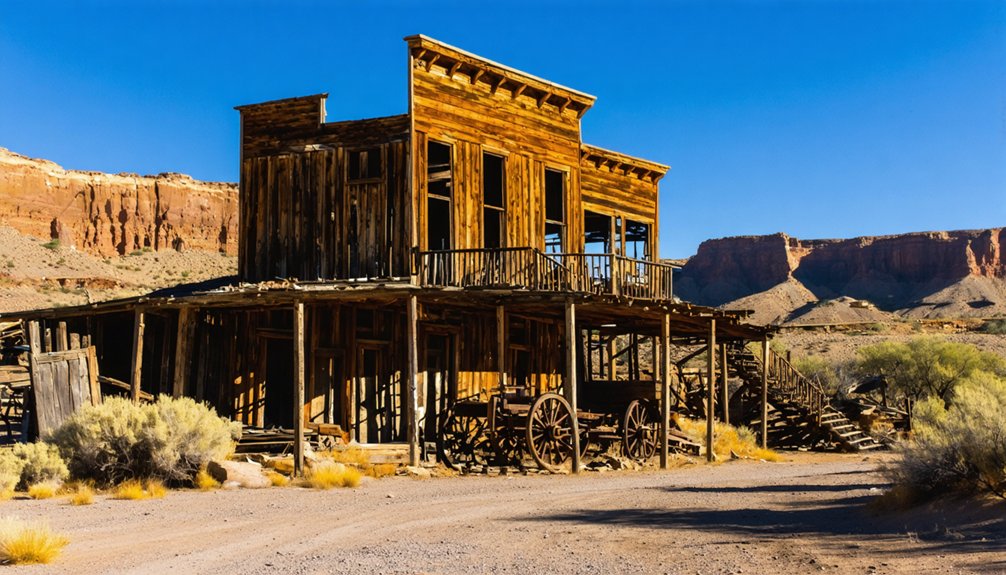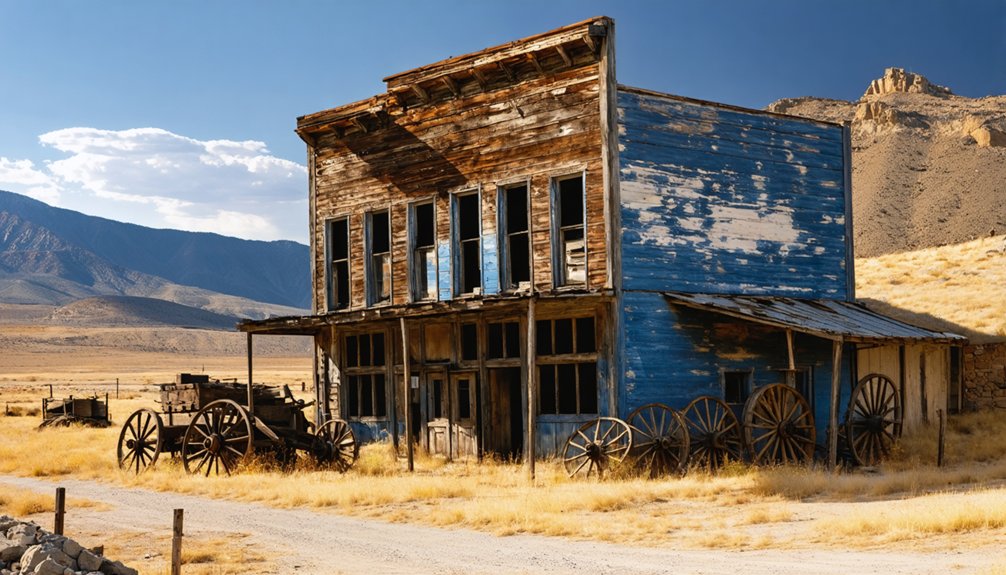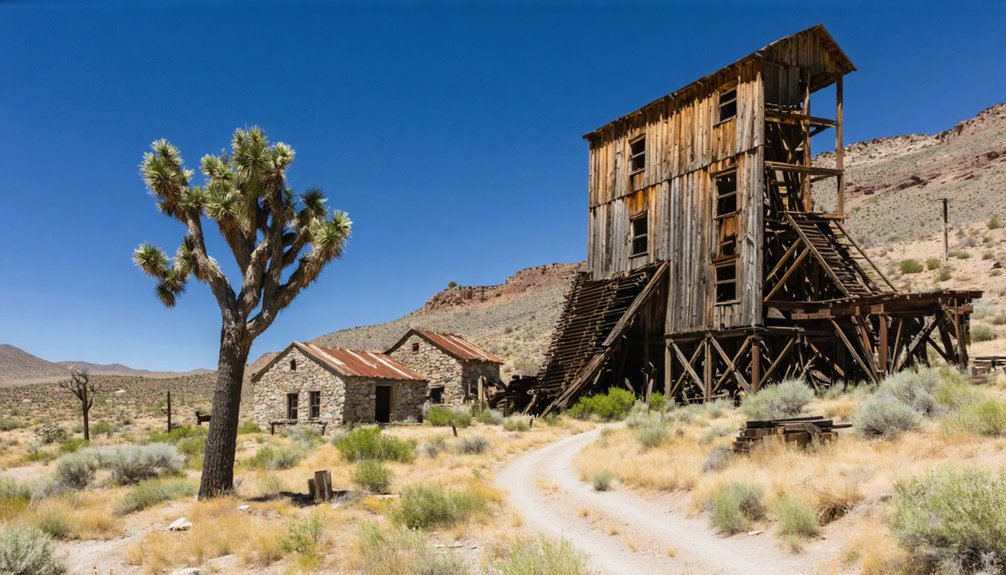You’ll find Blue Mountain’s fascinating story beginning in 1862 when pioneer rancher Woody established the settlement. After gold and silver discoveries in 1863, it transformed into Blue Mountain City, with the Heckendorn Mining Company leading operations. The town flourished through copper discoveries in 1891 and advanced mining technology, including 100-stamp mills and extensive water pipelines. Though mining ceased in the 1960s, Blue Mountain’s rich history holds countless tales of California’s mining heritage.
Key Takeaways
- Blue Mountain City was established in 1863 following significant gold and silver discoveries, becoming a bustling mining settlement.
- The town thrived on rich mineral deposits, with the Chloride mine alone producing $535,000 by 1896.
- Residents endured harsh living conditions while building a community with saloons, social gatherings, and vigilante justice systems.
- Advanced mining technology included stamp mills, Bryan mills, and a 12-mile pipeline delivering water from the Colorado River.
- Mining operations eventually ceased due to diminished ore quality and natural disasters in the 1960s, leading to abandonment.
The Origins of Blue Mountain Settlement
While California’s high country remained largely unexplored in the mid-1800s, pioneer rancher Woody established the first settlement in the Blue Mountain area in 1862.
In the untamed California high country of the 1860s, rancher Woody ventured forth to establish Blue Mountain’s first pioneering settlement.
You’ll find that early settlers faced significant pioneer challenges in this remote mountain terrain, where minimal infrastructure and harsh climate tested their resilience. The settlement strategies initially focused on ranching, taking advantage of the available land and natural resources. Similar to Kaiser Steel’s operations, the community would later revolve around industrial development. Young men seeking fortune faced conditions similar to those in bad man from Bodie territory.
The discovery of copper in 1891 by Joseph Weringer, followed by quartz gold in 1894, transformed the community’s destiny.
You’ll see how these mineral discoveries triggered an influx of prospectors and entrepreneurs, shifting the settlement’s focus from ranching to mining. The promising ore deposits spurred rapid growth as supporting businesses emerged, and transportation routes connected Blue Mountain to neighboring mining communities.
Discovery of Mineral Wealth
Gold and silver discoveries at Blue Mountain sparked immediate interest in early 1863, leading to the establishment of Blue Mountain City that January.
You’ll find that within months, the Heckendorn Gold and Silver Mining Company had organized operations to extract ore containing both precious metals.
The rich deposits, characterized by high sulfide content and favorable silver-to-gold ratios, drove rapid development of the mining district that included notable properties like the Black Wonder, Gold King, and Heckendorn mines.
Like the later chrome mining operations in Grant County during World War I, these mines faced significant transportation challenges that impacted their development.
According to historical records from Calaveras County newspapers, the area quickly attracted prospectors and mining investors seeking to capitalize on the newly discovered mineral wealth.
Initial Copper Strike 1891
Discovery of copper in 1891 transformed Blue Mountain, California into a bustling mining destination during America’s western mineral rush. Local prospectors and mining entrepreneurs flocked to the region, drawn by the promise of untapped mineral wealth in its rugged terrain. Just as convict labor leasing had driven mining economics in Tennessee that same year, western mining operations relied heavily on finding cost-effective workforce solutions. While Tennessee struggled with labor issues, African American workers were disproportionately impacted by exploitative mining practices across the country.
The initial copper prospecting efforts quickly led to significant developments:
- The Chloride mine emerged as a powerhouse, producing $89,373 in its first year.
- By 1896, the mine’s total yield reached an impressive $535,000.
- The Copper Mountain Mining Co. established major operations in the area.
- Advanced milling technology, including Bryan mills and percussion tables, was implemented.
Mining entrepreneurship flourished as both independent prospectors and established companies invested in the region’s infrastructure, building mills and developing transportation networks to support the growing industry.
Gold Found In 1894
Fresh gold discoveries in 1894 transformed Blue Mountain’s mining landscape, shifting focus from copper to a diversified mineral portfolio.
You’d find this discovery differed greatly from California’s famous 1848 Gold Rush, as it centered on quartz veins rather than placer deposits.
The region’s gold mining operations quickly evolved from simple prospecting to industrialized extraction methods.
You’ll notice how miners had to adapt, replacing traditional panning with advanced hard rock mining techniques to access the polymetallic ore bodies containing gold, silver, and copper.
By 1899, the area was booming with new mining technologies and infrastructure.
This development pattern contrasted with California’s early mining days when panning for gold dominated before advancing to more sophisticated methods.
The area’s development was very different from when James W. Marshall first discovered gold at Sutter’s Mill, triggering the original California Gold Rush.
While some claims were overvalued due to speculation, successful operations like those in the Cracker Creek district proved the region’s genuine mineral wealth, attracting skilled miners and sustained investment throughout the early 1900s.
Mining Rush Begins Fast
After gold and silver mineralization surfaced in Calaveras County during the early 1860s, Blue Mountain’s mining district rapidly emerged as a bustling hub of activity.
The discovery sparked intense mining competition as prospectors rushed to stake their claims in what would become a legendary California mining district. Like the early 1850s prospectors before them, these miners were drawn by the promise of mineral wealth in the region’s limestone-rich terrain. Many miners came well-prepared after seeing how supply merchants had profited more reliably than the gold seekers themselves in previous rushes.
You’ll find that four key developments shaped the initial rush:
- Independent prospectors immediately descended on the area, employing various prospecting strategies to locate both placer gold and hard rock deposits.
- The Heckendorn Gold and Silver Mining Company organized by July 1863, leading industrial-scale operations.
- Blue Mountain City sprang up quickly to support the surging population.
- Infrastructure, including a post office and essential services, developed at breakneck speed to serve the mining community.
Mining Operations and Technology
You’ll find that Blue Mountain’s mining operations relied heavily on stamp mills, with up to 100 stamps processing ore during peak production periods.
The introduction of finer crushing screens in 1896 greatly improved gold recovery rates from the district’s low-grade ore.
An essential 12-mile pipeline delivered 250,000 gallons of water to the mills from the Colorado River, costing miners about ten cents per ton of crushed ore.
Extraction Methods and Equipment
Mining operations at Blue Mountain employed both traditional and evolving extraction methods throughout its operational history.
You’ll find that early extraction techniques relied heavily on manual labor and basic mining equipment, with miners using hand-powered drills and hammers to break through rock formations.
The progression of mining technology at Blue Mountain included:
- Timber support systems featuring posts and sets to prevent tunnel collapse
- Steam-powered pumps to keep underground workings dry and operational
- Narrow-gauge tracks with hand-loaded ore cars for material transport
- Ventilation systems utilizing natural airflow enhanced by furnace shafts
As operations advanced, these methods proved essential for accessing deeper ore deposits.
The introduction of mechanical ventilation fans and improved pumping systems later enhanced both safety and efficiency in the underground workings.
Early Copper Mining Techniques
When copper was first discovered at Blue Mountain in 1863, prospectors encountered malachite deposits within distinctive blue schist formations that sparked a brief but intense mining rush.
You’ll find that early techniques were fairly rudimentary, with miners digging shallow shafts along ridgelines and using basic manual extraction methods. They’d stack ore and wood for open roasting to burn off sulfur compounds, though this practice devastated nearby vegetation.
The mining methods proved challenging, as workers had to transport ore by wagon to Stockton, then by riverboat to San Francisco, and finally by sailing ship to East Coast smelters.
When copper prices plummeted from 55 to 19 cents per pound after the Civil War in 1865, these inefficient processes couldn’t sustain profitability, leading to the rapid abandonment of most operations within a year.
Life in a California Mining Town

Life in California mining towns tested the resilience of even the hardiest settlers, as residents faced harsh living conditions and constant challenges.
You’d find yourself living in makeshift housing, dealing with poor sanitation, and battling frequent fires that swept through closely packed wooden structures.
Community resilience emerged through these mining challenges, as residents established their own social order and justice systems.
In these male-dominated settlements, you’d experience:
- Saloons serving as community hubs for entertainment and socializing
- Vigilante justice handling disputes in the absence of formal law enforcement
- Ethnic enclaves forming distinct neighborhoods and support networks
- Community events like dances and religious gatherings providing rare moments of unity
Despite the hardships, settlers created functioning communities, though food and water remained scarce, and disease spread rapidly through the camps.
Economic Growth and Peak Years
While settlers grappled with harsh living conditions, Blue Mountain’s economic engine roared to life in the 1850s as prospectors discovered rich deposits of placer gold near Columbia, CA.
You’ll find that early economic diversification emerged through limestone and marble quarrying, with a notable marble block destined for a George Washington monument in D.C.
The Community and Its People

Life in Blue Mountain City centered around the mining industry, where you’d find families adapting to the challenging conditions of a remote settlement built on a flat bench above the steep mining camps.
Mining families formed tight-knit social bonds through their shared experiences and interdependence, with daily routines revolving around the men’s work schedules in the nearby Black Wonder and Gold King mines.
The community’s social fabric was strengthened by the basic amenities like the post office, which served as a connection point where you could encounter neighbors and share news about mining prospects.
Daily Life and Traditions
Nestled within the vibrant community of Blue Mountain, residents enjoyed a remarkably self-sufficient lifestyle supported by extensive amenities and services.
You’d find daily life centered around community gatherings and recreational activities that brought neighbors together in meaningful ways.
Life in Blue Mountain offered you:
- Morning walks to nearby schools and shopping centers along landscaped streets
- Afternoons at the community pool, tennis courts, or bowling alley
- Evening baseball games under the lights or church social events
- Weekend community gatherings at the auditorium and park
Whether you were attending one of the eight churches, playing sports with neighbors, or seeking medical care at the integrated healthcare facility, Blue Mountain’s infrastructure guaranteed all your daily needs were met within walking distance of home.
Mining Family Relationships
At the heart of Blue Mountain’s social fabric, mining families formed intricate networks of relationships that shaped the community’s development throughout the late 19th century.
You’d find prominent figures like Asahel Loop and his extended family leading the way in claim staking and district formation, establishing essential family alliances that defined the region’s mining landscape.
Mining partnerships often emerged through strategic marriages and kinship ties, allowing families to pool resources for expensive operations like stamp mills and prospecting ventures.
You’ll notice how these family networks adapted to changing times, shifting from gold to tungsten mining during World War I.
The multi-ethnic character of these relationships became evident as Chinese families established their own enclaves while integrating into the broader mining economy through business partnerships and labor arrangements.
Decline of the Mining Era
Though Blue Mountain’s gold mining operations began promisingly in the 1850s, the area’s decline became evident as placer deposits proved less productive than the nearby Columbia basin.
You’ll find that several key factors hastened the town’s transformation into a ghost town, beyond just mining regulations and environmental concerns.
Here’s what led to Blue Mountain’s downfall:
- Ore quality diminished considerably, with sulfide content decreasing and gold grades becoming less economically viable.
- Limited silver byproduct and shallow oxidation zones of only 30-50 feet restricted mining potential.
- 19th-century technology couldn’t efficiently process the complex sulfide ores.
- Abandoned mines leaked mercury, arsenic, and lead, making the land increasingly hazardous.
Without alternative industries and faced with these challenges, the mining workforce dispersed, leaving behind thousands of abandoned mines across the Sierra Nevada.
Architectural Remains and Artifacts

The skeletal remains of Blue Mountain’s architecture tell a compelling story of its mining-era prosperity.
You’ll find wooden houses and brick buildings scattered across the landscape, now succumbing to architectural decay. The town’s layout reveals a carefully planned community, with clustered public buildings serving the mining workforce.
As you explore the ruins, you’ll discover the remnants of schools, churches, and industrial structures that once formed this thriving settlement.
Artifact analysis has uncovered construction materials, mining tools, and personal items that paint a picture of daily life. The harsh desert climate continues to erode what’s left – from roofless homes to crumbling brick foundations and rusted machinery.
These fragments, though deteriorating, preserve the essence of a once-bustling mining community frozen in time.
Historical Legacy and Preservation
Since its brief heyday in 1863, Blue Mountain City’s historical legacy has faced mounting preservation challenges. The town’s rapid abandonment by 1864 left few physical remains, while natural erosion and weathering continue to threaten what’s left of this Gold Rush-era settlement.
You’ll find Blue Mountain’s story preserved mainly through:
- Local oral histories and accounts from Calaveras County residents
- Historical registries and ghost town documentation efforts
- Cultural heritage organizations focused on mining-era preservation
- Corporate records from early mining companies like Heckendorn
Without formal historic designation or protective status, the site remains vulnerable to both environmental damage and human impact.
The steep canyon location and lack of infrastructure make preservation efforts particularly challenging, though Blue Mountain’s cultural memory endures as part of California’s broader mining heritage.
Blue Mountain’s Place in California’s Mining Heritage

During California’s bustling Gold Rush era, Blue Mountain City emerged as a remarkable mining settlement in 1863, characterized by its distinctive gold and silver deposits within quartz veins.
Blue Mountain City rose from California’s Gold Rush landscape in 1863, its quartz veins gleaming with precious gold and silver deposits.
You’ll find its historical significance reflected in the pioneering mining techniques used to extract precious metals from the area’s unique ore composition, where silver content often exceeded gold by tenfold.
The district’s notable mines, including Black Wonder, Gold King, and Heckendorn, contributed to California’s mineral wealth through both primitive and evolving mining techniques.
While the settlement’s post office operated briefly from 1863 to 1864, the mining operations persisted intermittently for decades, producing up to $200,000 in valuable minerals.
Though natural disasters eventually halted operations in the 1960s, Blue Mountain’s legacy endures as a reflection of California’s dynamic mining heritage.
Frequently Asked Questions
Are There Any Paranormal Activities Reported at Blue Mountain Ghost Town?
You won’t find documented ghost sightings or haunted history at this location. While other California ghost towns boast paranormal activity, there’s no concrete evidence of supernatural occurrences at this site.
What Is the Best Time of Year to Visit Blue Mountain?
Like a golden paintbrush on nature’s canvas, fall (September-October) offers you perfect weather conditions and seasonal events. You’ll enjoy warm days, spectacular autumn colors, and extended daylight hours for exploring freely.
Is Blue Mountain Ghost Town Accessible by Regular Passenger Vehicles?
You’ll want to avoid taking a regular car due to rough road conditions and rocky terrain. High-clearance or four-wheel drive vehicles are strongly recommended for safely traversing the unpaved access routes.
Are Metal Detectors Allowed at the Blue Mountain Site?
You can’t legally use metal detectors here without special permits. Due to strict metal detecting regulations protecting historical artifacts, you’ll need archaeological research permissions or face penalties for unauthorized searches.
What Dangerous Wildlife Might Visitors Encounter at Blue Mountain?
You’ll need to watch for coyotes, bobcats, mountain lions, wild pigs, and rattlesnakes during your wildlife encounters. Practice safety by staying alert, avoiding dense brush, and never approaching or feeding animals.
References
- https://www.sfgate.com/travel/article/eagle-mountain-california-ghost-town-18096768.php
- https://www.youtube.com/watch?v=5DOGtWL8pWM
- https://www.visitcalifornia.com/road-trips/ghost-towns/
- https://en.wikipedia.org/wiki/List_of_ghost_towns_in_California
- https://californiahighsierra.com/trips/explore-ghost-towns-of-the-high-sierra/
- https://www.hmdb.org/m.asp?m=83341
- https://www.youtube.com/watch?v=2Foz-2R_mH8
- https://nvtami.com/2022/10/11/lessor-known-mono-inyo-ghost-towns/
- https://en.wikipedia.org/wiki/Blue_Mountain_City
- https://pubs.usgs.gov/of/1994/0677/report.pdf



